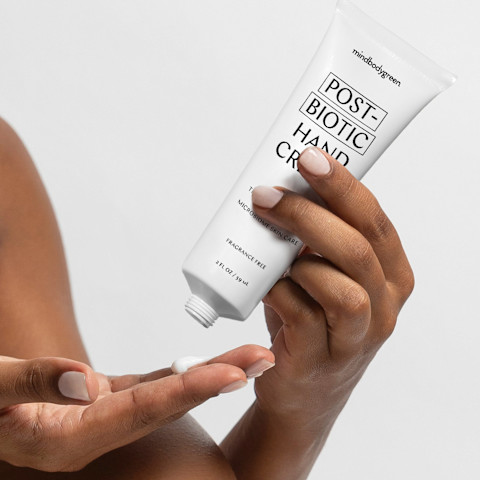Looking For A High-Quality, Healthy Aging Hand Cream? Look For These 3 Things

When buying a beauty product—be it a face serum, hair conditioner, or hand cream—it often feels like a gamble. There's no way to truly know if a formula is going to be effective, appropriate for your unique needs, and sensorially appealing for your particular tastes. Unfortunately, the only method to rely on is to, well, test out the product for yourself.
That being said: There are clues you can look for to ensure your selection is at the very least high quality and well crafted. This will set you up for success so you have a better chance of actually enjoying the product. (Ultimately, however, product preference is highly personal—just because something is good doesn't mean it's good for you. And that's OK!) These characteristics of quality vary depending on the type of product. For example, what's important for a retinol serum will be vastly different from what's important for a dark-circle-reducing eye cream.
So, how can you find a hand product that will help hydrate the skin, smooth fine lines, address discoloration, and protect the barrier? Look for these three key characteristics.
Humectants, emollients & occlusive ingredients
The foremost priority of a hand cream is to hydrate the skin. If it can't do that well, nothing else matters. So we have to start here. The best moisturizers contain a blend of humectant, emollient, and occlusive ingredients. This ensures the formula attracts and holds water in the skin, supports the lipid layer of the skin, and seals in hydration, which will reduce transepidermal water loss.
If you want to make sure yours is checking all the right boxes, peek at the ingredient list. You'll get a rough idea of the formula's moisturization potential if you see a smattering of the below ingredients:
- Humectants: Hyaluronic acid, glycerin, aloe vera, sodium PCA, honey, panthenol, polyhydroxy acids
- Emollients: Oat extracts, moringa seed oil, shea butter, squalane, jojoba oil, cocoa butter, mango seed butter, sunflower seed oil, safflower seed oil, fruit extracts
- Occlusives: Beeswax, plant waxes (like cetearyl olivate, sunflower wax, and castor wax), lanolin, olive oil
Please note that this list is not exhaustive—there are simply too many ingredients to list here, but I included some of the most notable natural and clean options.
Biome-supporting formula
The microbiome is an essential part of our skin barrier function—when the microbiome is in dysbiosis, it leads to inflammation, sensitivity, dryness, collagen loss, dark spots, fine lines, and premature aging. We need a robust, balanced, and thriving microbiome to keep our skin looking (and feeling) healthy1.
"No new skin care product that comes to market can claim to benefit the skin without keeping the microbiome in mind, using ingredients that support a healthy microbiome, and avoiding ingredients that disrupt or damage the microbiome," says board-certified dermatologist Whitney Bowe, M.D.
The good news is that many ingredients commonly used in moisturizers are also good for the microbiome. For example, colloidal oatmeal2 has been shown to be beneficial for the balance of the skin microbiome and can even help manage inflammatory skin conditions. Or antioxidants can also benefit the microbiome, as they ward off damaging free radicals and inflammation.
You can also look for more targeted approaches to supporting your microbiome, through prebiotics, postbiotics, and botanical ferments. Prebiotics support the diversity and health of your existing microbiome—look for plant sugars, algae, and minerals.
Postbiotics and botanical ferments supply the skin with an array of prized nutrients. Researchers have been able to identify very important outputs fermented from the bacteria living on our skin3, such as antimicrobial peptides, ceramides, essential fatty acids, hyaluronic acid, and antioxidants. Postbiotics and ferments are essentially a shortcut to healthy skin—as they recreate the benefits of a healthy microbiome.
Healthy aging antioxidants
"People often ask how many antioxidants you should be using regularly; the answer is: the more the better," board-certified dermatologist Rachel Nazarian, M.D., of Schweiger Dermatology Group told me about antioxidants. "The more you can help neutralize unstable molecules caused by free radical formation, the longer you can salvage the health of your cells and skin. There's really no limit to how much you can protect and repair your body!"
She's not wrong: We should be loading up on antioxidants whenever we can, including your hand cream.
There's an assortment of antioxidants to pick from, each with its own unique benefits. Here are a few:
- CoQ10: This lipid-soluble antioxidant helps with cellular energy production4, which means it can help your skin cells remain youthful. It also protects against lipid peroxidation5, which is just a fancy way of saying it ensures your skin cell membranes stay strong.
- Vitamin C: This derm-favorite antioxidant not only brightens, but it can help with collagen production. Vitamin C is a vital part of the collagen synthesis process.
- Niacinamide: This B vitamin supports the skin barrier and can help fade dark spots.
- Resveratrol: This polyphenol is used to reduce inflammation in the skin and support rejuvenation6.
- Astaxanthin: This marine extract is a carotenoid that is 6,000 times more potent in its free-radical-fighting power than vitamin C.
The takeaway
If you are in the market for a new hand cream but don't know where to start looking—these guidelines should lead you to the right place. You can also check out our favorite hand creams, as we did all the testing for you.
6 Sources
- https://www.ncbi.nlm.nih.gov/pmc/articles/PMC9320090/
- https://pubmed.ncbi.nlm.nih.gov/32484623/
- https://www.sciencedirect.com/science/article/abs/pii/S0924224417302765
- https://www.ncbi.nlm.nih.gov/pmc/articles/PMC4737275/
- https://www.ncbi.nlm.nih.gov/pmc/articles/PMC5514578/
- https://pubmed.ncbi.nlm.nih.gov/29737899/

